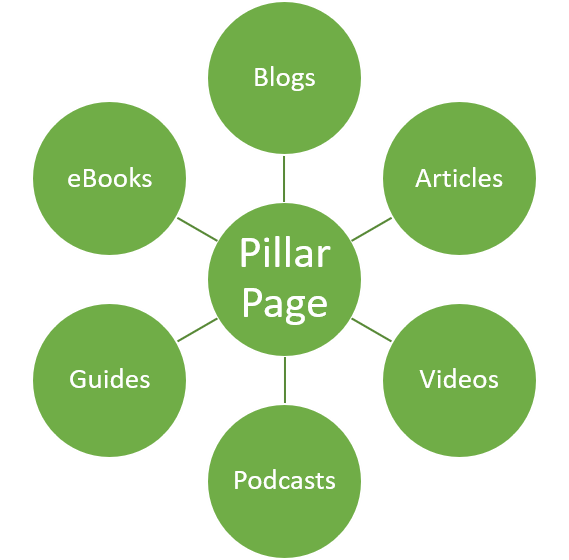If you are still working away at 1,000-word blogs and long-tailed keywords, you are behind the curve.
1,000 words won’t get you noticed. However, an organized collection of related content will. The new game is pillar pages.
What’s a pillar Page?
It is the center of a topic cluster—a collection of blogs, web pages, or anything else exposed to a search related to a single topic.
And it has fundamentally changed the way we manage our content—because Google has changed the way it regards the quality of that content.
What drives the change is the proliferation of junk content on the internet. Because of that, Google has made changes in technology, and people have changed their behavior.
- People are using longer search terms and learning how to be more specific about their search queries.
- Natural language processing has become more capable of understanding human intent and more specific requests.
- Google still wants to help searchers find the most accurate information so they can keep people on the Google platform and sell ads.
As a result, when Google crawls your site, it needs to find all of the information you have on a topic to have a chance of serving up the correct answer.
It requires a new organization by main topics, with specific content interlinked to address as many searches as possible about a particular subject.
How to Create Content Clusters and Pillar Pages

You may have been creating content for a long time. In that case, you undoubtedly have a vast collection of content—unorganized and outdated. The marketing gurus told us that frequent blogging works, so we just kept churning it out.
Creating clusters and pillar pages will fix all that. So, let’s see how to get started.
1. Inventory Your Content
- Organize content by topic and keyword.
- Evaluate it by quality, relevancy, and freshness. Is it the most up-to-date treatment of the content?
- Put poor quality or outdated content in a prioritized list of content to be updated.
- If it is irrelevant, retire it. No matter how clever.
2. Create an Update Schedule
Schedule a date to review and update each piece of content update within one year after you create or update it. Google still places a high priority on freshness.
Updating content doesn’t mean just putting on a new face. The update must have substance.
- Find new, updated references with new data and draw new conclusions.
- Expand it with new information.
3. Organize Clusters
Each cluster should have a main topic, subtopic, sub-sub topics to create a network of related information.
Identify which content will link to other content and how. Will it be a “Learn more” type of link or an inline reference to supporting information?
4. Create Pillar Pages
If you already have an article or series of articles covering a broad topic to support a group of blog articles, you can update the article or create one that treats the articles as chapters.
Don’t just slap a series of articles together. Write an engaging introduction. Update every chapter and build transitions between them. Moreover, each chapter or subheading should have a more specific keyword based on the parent keyword.
5. Choose Keywords and Start Blogging
Use the keywords in your topic cluster to create linked content, and link that content back to the pillar page.
Contact me to get started
If you are ready to think seriously about pillar pages and content clusters or have questions, contact me.
If you’d like to see a sample, click here to look at a draft awaiting publishing.
